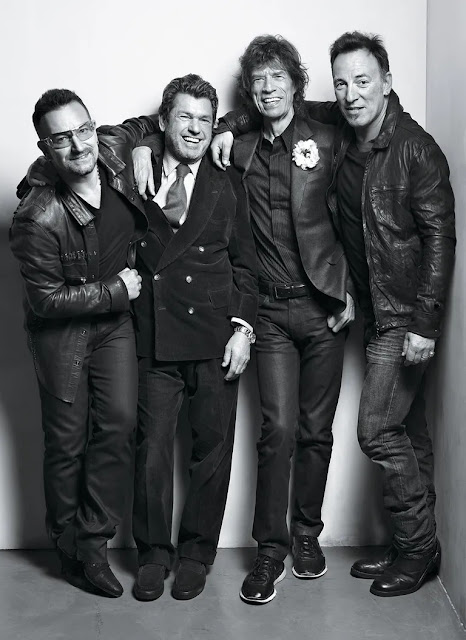...just none of them were articulate on this intellectual level...I mean, they just didn't articulate on this level.
--Jann Wenner, when asked why there are no women or persons of color in his upcoming book of interviews with rock musicians.
It was this--the radical conventionality of Rolling Stone--that was Jann Wenner's most important innovation. When he stamped the whole package with a psychedelic logo designed by poster artist Rick Griffin--the curled ligatures and looping serifs unmistakable signifiers of dope-peddling head shops on Haight-Ashbury--he instantly legitimized and mainstreamed the underground.
Wenner had never been, exactly, a revolutionary. He wanted to overthrow the establishment by becoming the establishment. The establishment, meanwhile, wanted a taste of the new fame and glamour that Rolling Stone was charting.
Pincered between disco and punk, Wenner defaulted to what did sell: Hollywood celebrities and 1960s-era rock icons of the kind he had been putting on the cover since 1967.
Wenner's biases and machinations--his success--had made him the gatekeeper of the history of rock and roll. And the next step was to build an institution out of it--literally, an edifice--over which he could preside...he was fashioning himself into the architect of rock's shining city on the hill: the Rock and Roll Hall of Fame.
It was a man’s magazine, though women read it; it was a white magazine, though African Americans were fetishized in it.
--Joe Hagan, Sticky Fingers: The Life and Times of Jann Wenner and Rolling Stone Magazine
In the future the pantheon will be decentralized.
--Richard Brody








“It was a man’s magazine, though women read it; it was a white magazine, though African Americans were fetishized in it.” That perfectly sums it up.
ReplyDeleteYes, Mithcell, but the thing is, if you were a teenager like I was in the 1970s, and you went to the high school library during study hall break, picked Rolling Stone from the magazine rack, you didn't compare it to other underground newspapers, because THERE WERE NO underground newspapers in the high school library. Instead, you compared it to Time, Newsweek, People, Reader's Digest, etc., and by that comparison, Rolling Stone was the most liberating, radical magazine you'd ever seen in your life, and that's what Wenner was literally banking on.
DeleteYes, Wenner certainly revealed his true colours as a sexist and racist man of privilege. I don't know why anyone is surprised.
ReplyDeleteDebra, had Wenner titled his book CRONY JOURNALISM: INTERVIEWS WITH MY BROS, the women-and-people-of-color question probably never would have come up (though maybe it still should have.)
DeleteWhy should anyone be surprised that the Rock industry is a commercially enterprise, and those connected with it are not any better than other executives, and have the same pecuniary (and other) considerations.
ReplyDelete--Jim
Jim, because in the 1960s rock music briefly (in retrospect very briefly) became entangled with counterculture idealism, and ever since then it's been held to a higher standard. Though not a musician, Wenner's has done everything he can to present himself as the embodiment of 1960s rock, and now that higher standard has bit him in the butt.
DeleteKind of off topic, but not...the very first article I read about Mick Jagger was an interview he did with Playboy (I was probably about 10? and snuck into my father's side of the closet and happened upon the magazine). I read it and became fascinated by him. A couple months later, he was on tv and I said "oh that is Mick Jagger". My uncle gave me a WOW look and said "how do you know". I quickly panicked and thought, he knows I looked at the Playboy magazine. I said "oh, umm he was on the news another day". My uncle then proceeded to tell me he was a Rolling Stones fan and it was great that I knew who he was...SHEW...LOL
ReplyDeleteThat's a great story, JM. I remember happening on one of my father's Playboys around the same age and seeing Little Annie Fanny. My reaction: "Oh, cool, Playboy has a COMIC STRIP!". Some years later I found out LAF was written by Mad magazine founder Harvey Kurtzman and illustrated by original Mad artist Will Elder. That made it cooler still.
Delete